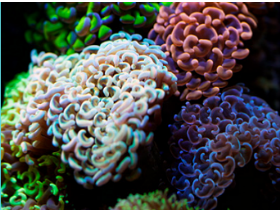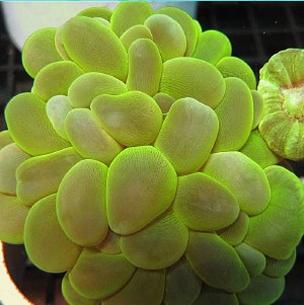Leather corals are typically brown, tan, cream or green in color. Their stalks are smooth and without polyps. However, their ends flare out in a broad mushroom shape where the polyps are located. Leather corals can survive under a range of light intensities but most thrive at the bottom of the tank under normal to low lighting. They also do well with a low current.


The Hammer Coral is a large polyp stony coral. Its common names are derived from the appearance of its hammer-, or anchor-shaped tentacles. Its polyps are visible throughout the day and night and hide its skeletal base. It may be green, tan, or brown in color, with lime green or yellow tips on the ends of its tentacles that glow under actinic lighting. Some varieties may be branched.
It is moderately difficult to maintain, but with proper water conditions in the aquarium, it will thrive. It will require moderate lighting combined with moderate water movement within the aquarium. At night, its sweeper tentacles can extend up to six inches in the reef aquarium, stinging other species of corals and animals. Allow plenty of room between it and other neighboring corals. For continued good health, it will also require the addition of calcium, strontium, and other trace elements to the water.

The Actinodiscus Mushroom - This variety of mushroom coral is metallic green, and under actinic lighting appear to fluoresce. They are a wonderful invertebrate for bottom placement in a reef aquarium. Over time, they will reproduce, forming a carpet covering the rockwork and sand.
They are hardy and easy to maintain. In general, they need a medium light level, and should be placed lower in the tank if the light intensity is high. These mushrooms require a low to moderate indirect water flow. Too much water movement will inhibit these mushrooms to fully expand. They are semi-aggressive and require adequate space between themselves and other corals and sessile invertebrates.
The Green Fluorescent Mushroom receives most of its nutritional requirements through the photosynthesis of the symbiotic algae zooxanthellae which it hosts. It also feeds on other nutrients and particulate matter and benefits from additional food in the form of micro-plankton or brine shrimp fed to each polyp of the colony.
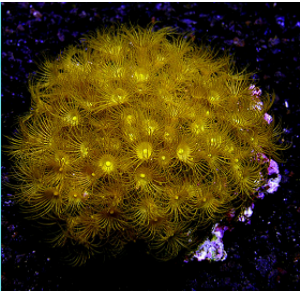
Yellow Colony
Polyp Coral
The Yellow Colony Polyp Corals are colonial animals with several individual polyps attached to a piece of live rock or coral rubble. They are bright yellow in color and their polyps have the ability to sting other polyps or corals. While the sting is not strong, they are semi-aggressive and need to have space between their colony and any neighbors.
Easy to maintain, the Colony Polyp Corals require a medium light level combined with a medium water movement within the aquarium. For continued good health, they will also require the addition of iodine and other trace elements to the water.
They will reproduce easily in the reef aquarium by budding (splitting off a portion of their base or mouth), which will increase the size of their colony.
They contain the symbiotic algae zooxanthellae which provide some of their nutritional requirements. They must also have additional feedings of micro-plankton or brine shrimp given to each individual of the colony.

The Purple Frilly Gorgonian create a beautiful display of height and motion in the home reef aquarium. It has a thorny, skeletal axis that has the elasticity of stiff rubber, allowing it to sway while filter feeding in strong currents without breaking. It is peaceful, but it should be given adequate space away from neighboring corals or anemones. It is more challenging to maintain this species, as they require supplemental feeding several times per week. This Sea fan is photosynthetic and requires a moderate amount of light depending on the amount of filter feeding food that is available.
In order to inhibit algae and cyanobacteria growth, it is important that this gorgonian is provided with a medium to strong, constant or intermittent water flow. If in the event that it does begin to become covered with algae or cyanobacteria, remove it from the coral immediately, as this will cause rapid tissue deterioration.
Algae can be removed gently with the use of a soft brush; combat cyanobacteria by soaking the coral in fresh water of the same temperature for approximately 1 minute. These corals will also benefit from the addition of iodine, calcium, strontium, and other trace elements to the water.
The Purple Frilly Gorgonian should be fed a few times a week with a filter feeding food. Provide a varied diet of live or frozen baby brine shrimp, Marine Snow, PhytoPlan and other suitable micro foods.
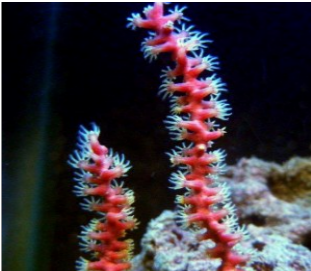
The Red Finger Gorgonian is also referred to as Red Tree Gorgonian, or Colorful Sea Rod. An attractive branching tree-like coral, it is extremely brittle and breaks easily, making it easy to propagate in this way.
It basically is available in two color variations being bright orange-yellow with red and white polyps, or deep red to purple with white polyps. This sea fan will usually grow in small and sparsely branched colonies.
It is peaceful, but it should be given adequate space away from neighboring corals or anemones. Underwater epoxy is commonly used to anchor its base to a piece of live rock in the reef aquarium.
It is difficult to maintain even in the well-established reef system. It is not photosynthetic and requires a low level of lighting to ward off a build-up of microalgae. It also requires a stronger water flow and the addition of iodine, calcium, strontium, and other trace elements to the water.
Since it is not photosynthetic, its survival is dependent on regular and frequent feedings of micro-plankton, live, baby brine shrimp, or foods designed for filter feeding invertebrates.
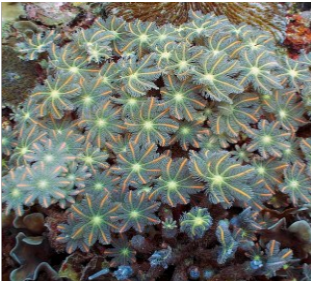
The Clavularia Clove Polyps are also commonly referred to as Eight Tentacle Polyps, or Encrusting Polyps. They are brown, tan, pink, green, or white in color and their polyps have the distinctive eight-leaved tentacles associated with all the members of this family.
They are colonial animals with several individual polyps attached to a single piece of live rock and are often stung and damaged by other aggressive corals. Therefore, they need adequate space between themselves and other corals.
They are not difficult to maintain and require moderate lighting combined with moderate water movement.
They require the addition of iodine and other trace elements to the water. They will grow rapidly in the established reef aquarium by encrusting over adjacent rock work or even other corals.
The symbiotic algae zooxanthellae hosted within their bodies is responsible for providing the majority of their nutritional requirements via the algaes light drive process of photosynthesis.
They also benefit from weekly feedings of micro-plankton or foods designed for filter feeding invertebrates.

The Plating Montipora Coral is a small polyp stony (SPS) coral often referred to as a Vase Coral. Montipora Corals come in a vast variety of forms and colors.
M. Capricornis is shaped like a vase; M. Digitata is generally a branching species; M. Stellata has rough, irregular, upright plates. Other species are encrusting. This form of Montipora is plating and will add diversity to your reef aquarium.
The Plating Montipora Coral is peaceful and can be placed in close proximity to other similar peaceful corals in the reef aquarium.
It is moderately difficult to maintain and should be housed in a mature reef aquarium.
It will require medium lighting combined with a medium water movement within the aquarium.
For continued good health, it will also require the addition of calcium, strontium, and other trace elements to the water.
They will thrive in a variety of lighting conditions, ranging from power compacts, VHO, T-5's up to the more intense metal halides. Alter their position in the aquarium depending on the lighting, and provide at least 3 watts per gallon using one of the lighting systems mentioned above.
It will also benefit from additional food fed weekly in the form of micro-plankton or foods designed for filter feeding invertebrates.
The Bubble Coral requires a moderate level of lighting combined with low to moderate water movement in the aquarium. Too much water flow may impede the coral from fully expanding.
The fleshy polyps of Bubble Corals are very fragile and will puncture easily. Be careful when handling these corals, to only handle them by the hard skeleton.
Because they can form long sweeper tentacles, be sure to provide plenty of room to prevent damage being done to its neighbors. For continued good health, it will also need the addition of calcium, strontium, and other trace elements to the water.
It will benefit from additional food fed weekly in the form of brine shrimp or micro-plankton.
The Doughnut Coral is a large polyp stony (LPS) coral and often referred to as the Cats Eye, Tooth, Doughnut, Teary Eye, or Meat Coral.
Its genus name, Cynarina, is derived from the Greek word kinara (artichoke) and ina (similar to) and as the naming foreshadows, it really does resemble an artichoke.
The Cynarina Button Coral is a round solitary coral, one of the largest single-polyped corals found in nature today, and available in many different color forms from pastel to bright and translucent, to drab variations. Sometimes, it is confused with its closest relative, Scolymia.
While it is not an aggressive coral, it should be provided with adequate spacing between itself and other corals because it can expand to twice its size.
It is easy to maintain in the reef aquarium and makes an excellent choice for both the beginner or advanced reef aquarist.
It requires medium lighting combined with low water movement. For continued good health, it will also require the addition of calcium, strontium, and other trace elements to the water.
It should be fed meaty foods such as micro-plankton or brine shrimp at night.
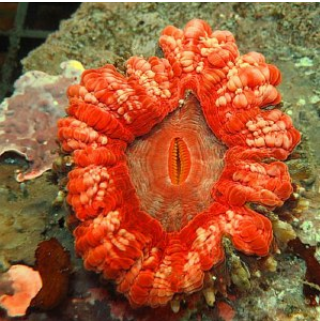


at is its maximum size?
They can reach half an inch
Where is its origin?
The Sexy Shrimp come from the Indo-Pacific.
Is it Reef Compatible?
Yes
What should I feed it?
The Sexy Shrimp is a scavenger and will eat a variety of foods, best to feed a varied diet of frozen foods and live food. Needs meaty foods
How many can I keep?
Can be kept together.
How compatible is it with fish?
Will cause no harm to fish although avoid housing with large or aggressive tank mates for fear of the being eaten due to their smalls size

What is its maximum size?
They can reach 6cm.
Where is its origin?
The Red Fire Shrimp come from the Indo-Pacific.
Is it Reef Compatible?
With caution, occasionally one may feed on some polyps.
What should I feed it?
This Shrimp is a scavenger and will eat a variety of foods, best to feed a varied diet of frozen foods and live food.
How many can I keep?
Can be kept together.
How compatible is it with fish?
Fish value the service it gives cleaning parasites off their skin. Occasionally you need to be careful with some very aggressive large fish.
Marine Invertibrates Shrimp
Genus Name - Lysmata Amboinesis
They can reach 5 cm. The Cleaner Shrimp come from Indo-Pacific.
It is a scavenger and will eat a variety of foods, best t o feed a varied diet of frozen foods and live food.
You can keep multiple cleaner shrimp together. Other fish value the service it gives cleaning parasites off their skin. Occasionally, you need to be careful with some very aggressive large fish.
The 'Sexy' Shrimp are small shrimp. They are usually less than 2 cm in size. Females are bigger than males, for example, males usually grow only up to 1.5 cm (0.6 inches) long.
It is a scavenger and will eat a variety of foods, best t o feed a varied diet of frozen foods and live food.
You can keep multiple cleaner shrimp together. Other fish value the service it
They have short-stalked eyes that are protruding from their carapace. The rostrum is well developed and does not overreach the eyes or expand ventrally.
The 'Sexy' Shrimp have a distinctive orange coloration with the number of large white spots outlined in blue. The abdomens and tails of these shrimp arch upwardly towards their heads.
Once a proper aquarium is set up and optimum living conditions are met, 'Sexy' Shrimp can grow, reproduce and live up to 3 years.
The Behavior of the 'Sexy' Shrimp
The 'Sexy' Shrimp are extremely interesting in terms of behavior. As I have already mentioned, the common name is coming from its unusual dance, which involves holding its abdomen up in the air and waving it up and down. They do their dance almost all the time.
They are completely peaceful creatures and usually do not bother anybody in the tank.
The 'Sexy' Shrimp are also very social and tend to aggregate in large groups potentially reflecting the small size and limited defensive capability of these shrimps.
They will often share a hiding place, it is not uncommon to see many of them in the same areas. In the group, they feel more relaxed and confident. At the same time, they lack social structure.
'Sexy' Shrimp can move very quickly and are capable of going short distances 15 - 20 cm (6 - 8 inches) in the blink of an eye.
This species is usually associated with corals and anemones, however, in aquariums 'Sexy' Shrimp can also live free without any anemones.





